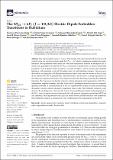| dc.contributor.author | Ponciano-Ojeda, Francisco | |
| dc.contributor.author | Mojica-Casique, Cristian | |
| dc.contributor.author | Hernández-Gómez, Santiago | |
| dc.contributor.author | Del Angel, Alberto | |
| dc.contributor.author | Hoyos-Campo, Lina M. | |
| dc.contributor.author | Flores-Mijangos, Jesús | |
| dc.contributor.author | Ramírez-Martínez, Fernando | |
| dc.contributor.author | Sahagún Sánchez, Daniel | |
| dc.contributor.author | Jáuregui, Rocío | |
| dc.contributor.author | Jiménez-Mier, José | |
| dc.date.accessioned | 2023-12-22T16:51:17Z | |
| dc.date.available | 2023-12-22T16:51:17Z | |
| dc.date.issued | 2023-12-01 | |
| dc.identifier.uri | https://hdl.handle.net/1721.1/153247 | |
| dc.description.abstract | This paper presents a general review of the results of the experimental and theoretical work carried out by our research group to study the <inline-formula><math xmlns="http://www.w3.org/1998/Math/MathML" display="inline"><semantics><mrow><mn>5</mn><msub><mi>P</mi><mrow><mn>3</mn><mo>/</mo><mn>2</mn></mrow></msub><mo stretchy="false">→</mo><mn>6</mn><msub><mi>P</mi><mi>J</mi></msub></mrow></semantics></math></inline-formula> electric quadrupole transition in atomic rubidium. The experiments were carried out with room-temperature atoms in an absorption cell. A steady-state population of atoms in the <inline-formula><math xmlns="http://www.w3.org/1998/Math/MathML" display="inline"><semantics><mrow><mn>5</mn><msub><mi>P</mi><mrow><mn>3</mn><mo>/</mo><mn>2</mn></mrow></msub></mrow></semantics></math></inline-formula> excited state is produced by a a narrow-bandwidth preparation laser locked to the D2 transition. A second CW laser is used to produce the forbidden transition with resolution of the <inline-formula><math xmlns="http://www.w3.org/1998/Math/MathML" display="inline"><semantics><mrow><mn>6</mn><msub><mi>P</mi><mi>J</mi></msub></mrow></semantics></math></inline-formula> hyperfine states of both rubidium isotopes. The process is detected by recording the 420(422) nm fluorescence that occurs when the atoms in the <inline-formula><math xmlns="http://www.w3.org/1998/Math/MathML" display="inline"><semantics><mrow><mn>6</mn><msub><mi>P</mi><mi>J</mi></msub></mrow></semantics></math></inline-formula> state decay directly into the <inline-formula><math xmlns="http://www.w3.org/1998/Math/MathML" display="inline"><semantics><mrow><mn>5</mn><mi>S</mi></mrow></semantics></math></inline-formula> ground state. The fluorescence spectra show a strong dependence on the relative polarization directions of the preparation laser and the beam producing the forbidden transition. This dependence is directly related to a strong anisotropy in the populations of the <inline-formula><math xmlns="http://www.w3.org/1998/Math/MathML" display="inline"><semantics><mrow><mn>5</mn><msub><mi>P</mi><mrow><mn>3</mn><mo>/</mo><mn>2</mn></mrow></msub></mrow></semantics></math></inline-formula> intermediate magnetic substates, and also to the electric quadrupole selection rules over magnetic quantum numbers. A calculation based on the rate equations that includes velocity and detuning dependent transition rates is adequate to reproduce these results. The forbidden transition is also shown to be an ideal probe to measure the Autler–Townes splitting generated in the preparation of the <inline-formula><math xmlns="http://www.w3.org/1998/Math/MathML" display="inline"><semantics><mrow><mn>5</mn><msub><mi>P</mi><mrow><mn>3</mn><mo>/</mo><mn>2</mn></mrow></msub></mrow></semantics></math></inline-formula> state. Examples of spectra obtained with cold atoms in a magneto-optical trap (MOT) are also presented. These spectra show the expected Autler–Townes doublet structure with asymmetric line profiles that result as a consequence of the red-detuning of the trapping laser in the MOT. | en_US |
| dc.publisher | Multidisciplinary Digital Publishing Institute | en_US |
| dc.relation.isversionof | http://dx.doi.org/10.3390/photonics10121335 | en_US |
| dc.rights | Creative Commons Attribution | en_US |
| dc.rights.uri | https://creativecommons.org/licenses/by/4.0/ | en_US |
| dc.source | Multidisciplinary Digital Publishing Institute | en_US |
| dc.title | The 5P3/2 → 6PJ (J=1/2,3/2) Electric Dipole Forbidden Transitions in Rubidium | en_US |
| dc.type | Article | en_US |
| dc.identifier.citation | Photonics 10 (12): 1335 (2023) | en_US |
| dc.contributor.department | Massachusetts Institute of Technology. Research Laboratory of Electronics | |
| dc.contributor.department | Massachusetts Institute of Technology. Department of Electrical Engineering and Computer Science | |
| dc.identifier.mitlicense | PUBLISHER_CC | |
| dc.eprint.version | Final published version | en_US |
| dc.type.uri | http://purl.org/eprint/type/JournalArticle | en_US |
| eprint.status | http://purl.org/eprint/status/PeerReviewed | en_US |
| dc.date.updated | 2023-12-22T13:45:17Z | |
| dspace.date.submission | 2023-12-22T13:45:17Z | |
| mit.license | PUBLISHER_CC | |
| mit.metadata.status | Authority Work and Publication Information Needed | en_US |
